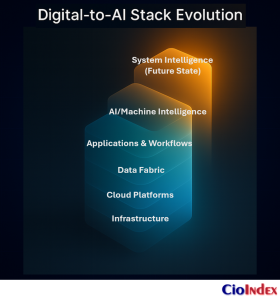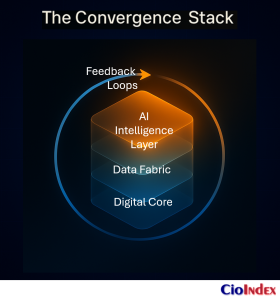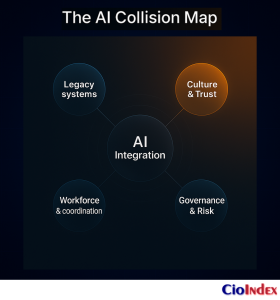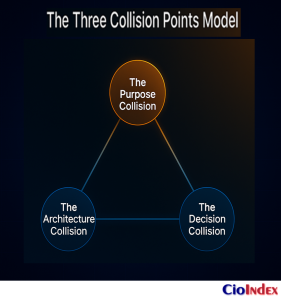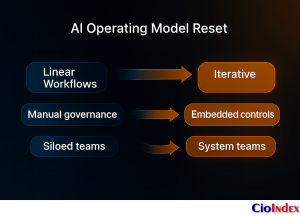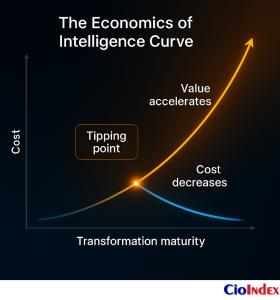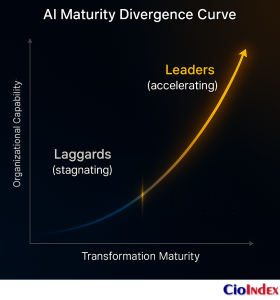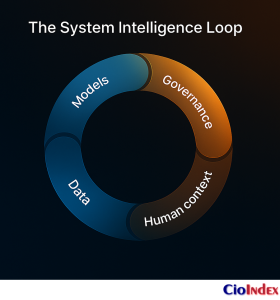The Collision Course That Was Never Inevitable
Digital transformation reshaped how modern enterprises build and operate their systems. Cloud architectures replaced rigid infrastructure. Platform-based design reduced complexity by standardizing how services interact. Data-driven workflows replaced manual interpretation, and operating models shifted toward more distributed, product-centric structures. These shifts created the foundations for more adaptive organizations. Artificial intelligence now presses against those same foundations—not as another layer of automation, but as a force that reveals the true condition of the environment it enters.
AI performs reliably only when the underlying system is coherent. It falters when the environment supplying its signals is fragmented, inconsistent, or slow. The difference becomes unmistakable when comparing enterpAs organizations advance towardrises that unified their data environments with those still operating across overlapping silos.
Citi’s consolidation of customer data—spanning credit products, digital channels, branch interactions, CRM systems, and risk platforms—shows how structural coherence changes the trajectory of intelligence. Once the bank brought these sources into a governed, integrated data foundation, AI models began producing stable and timely insights across product lines. Churn indicators sharpened. Credit decisions reacted dynamically to new signals. Personalized recommendations became accurate rather than approximate. Intelligence scaled because the environment supporting it was aligned.
A different outcome emerged during the Apple Card credit-limit controversy, where Goldman Sachs faced regulatory scrutiny for AI-driven credit decisions that produced inconsistent results for applicants with similar profiles. Investigations pointed not to model flaws but to fragmented data pipelines, uneven data quality, and misaligned model inputs. Intelligence interpreted these inconsistencies as meaningful variation. The model behaved logically according to its inputs; the environment around it did not.
These contrasts reveal the central paradox organizations now confront. AI was widely expected to accelerate digital transformation, yet in many enterprises it is exposing the gaps transformation never resolved. The same technology that propels some companies forward creates friction for others. Intelligence does not create maturity; it reveals it. It does not produce alignment; it reflects it. The determinant is not the model’s capability but the organization’s readiness for intelligence to operate within its systems.
This readiness is uneven because AI introduces a structural asymmetry: intelligence accelerates interpretation and decision velocity, while many organizational architectures, workflows, and governance models remain slow, manual, or inconsistent. The moment AI enters such an environment, it becomes a stress test—revealing architectural debt, cultural resistance, governance ambiguity, and strategic contradictions that transformation efforts treated as manageable.
AI does not choose convergence or collision. It amplifies what it finds. When data, architecture, governance, and operating models move in the same direction, intelligence becomes a natural extension of transformation. When those conditions diverge, AI widens the distance between aspiration and reality.
That widening distance is shaping competitive differentiation and determining why some organizations advance rapidly with AI while others struggle to absorb it. This is where the real story begins.
The Historical Split — Digital Transformation Built the Foundation. AI Raises the Stakes.
Digital transformation reshaped how enterprise systems are designed and how value flows through them. Cloud platforms replaced rigid infrastructure, data environments became more accessible, workflows evolved into modular, API-driven designs, and operating models shifted toward iterative, cross-functional structures capable of continuous change. Together, these shifts created the first version of the digital core—a system meant to absorb complexity through integration rather than containment.
Artificial intelligence interacts with this core differently from earlier waves of technology. Automation required stable inputs. Analytics required consistent history. AI requires coherence. Intelligence depends on architecture, data, workflows, and governance functioning as a single system. Any fragmentation across these layers becomes immediately visible once models begin operating at scale.
To understand the historical split that now determines AI readiness, three structural forces matter most: digital core integrity, data gravity and locality, and the coherence of cloud and operating models.
Digital Core Integrity: The Unfinished Work of Transformation
The integrity of the digital core is now the primary determinant of whether AI completes or complicates a transformation effort. Environments where cloud-native design, governed data pipelines, and platform-based integration have matured give intelligence a stable foundation. Capital One provides a clear view of how digital core integrity shapes AI readiness. Years of unifying customer, credit, fraud, and channel data—supported by API-first architecture and shared analytical platforms—reduced conflicting formats and eliminated the need for cross-departmental reconciliation. Fraud models update continuously. Credit models draw from multiple product lines without translation. Customer intelligence spans channels because they share lineage and structure. Intelligence scales because the core beneath it is structurally aligned.
Where the core remains fragmented, intelligence exposes the divide. Several NHS trusts attempted to deploy AI in triage, demand forecasting, and imaging across environments built on incompatible clinical formats, isolated care-setting records, and historical platforms that never converged. Patient data could not move across trusts reliably. Workflows varied significantly between facilities. AI models receiving inconsistent inputs generated unstable recommendations not because of inadequate algorithms but because the systems surrounding them lacked the interoperability, consistency, and locality AI requires.
Digital transformation built a partial foundation. AI reveals where that foundation remains incomplete.
Data Gravity, Locality, and Interoperability: The Hidden Constraints
Data gravity makes the split more pronounced. Information accumulates in systems faster than it moves between them, and AI requires access to coherent, unified signals. Capital One’s consolidated environment lowers the gravitational pull of siloed systems, allowing intelligence to operate with contextual completeness. NHS environments anchored in local repositories experience the opposite dynamic: data remains tied to legacy custodianship, restricting AI’s access to the volume and cohesion required for reliable inference.
Data locality reinforces this asymmetry. AI depends on data that can move freely across platforms, functions, and workflows. When data remains locked inside departmental systems, physical locations, or historical platforms, intelligence cannot interpret the full operational landscape. Interoperability becomes the enabling condition that digital transformation often promised but did not fully deliver.
Digital transformation improved data accessibility. AI now tests whether that accessibility has matured into true data mobility.
Cloud and Operating Model Coherence: The Final Layer of Readiness
Cloud modernization follows the same structural pattern. Shared, platform-centric environments provide the elasticity, connectivity, and distributed compute AI requires to train, update, and operate models. Partial or departmental cloud efforts create bottlenecks when intelligence attempts to span workloads tethered to legacy cores. AI amplifies these inconsistencies because it relies on real-time orchestration rather than isolated system behavior.
Operating models form the final layer of readiness. Product-based teams, integrated governance structures, and iterative delivery cycles give intelligence clear pathways of ownership and accountability. Capital One benefits from this coherence; its operating rhythm supports continuous learning loops because decision rights, processes, and data flows align. Fragmented organizations experience the opposite effect: AI accelerates the gap between decision speed and organizational capacity. Handoffs fail. Delays multiply. Misalignment between workflow design and model outputs becomes visible instantly.
The Digital Transformation → AI Readiness Gap
| Layer | What Digital Transformation Built | What AI Now Requires |
|---|---|---|
| Infrastructure | Cloud adoption, virtualized compute, flexible provisioning | High elasticity, low-latency processing, distributed compute |
| Data | Centralized repositories, ETL pipelines, dashboards | Real-time flows, lineage, governance, unified ontologies |
| Applications | Modular workflows, API integration | Event-driven orchestration, dynamic routing, intelligent automation |
| Operations | Agile practices, DevOps, iterative delivery | Continuous learning loops, model lifecycle integration |
| Governance | Policy frameworks, compliance processes | Embedded controls, rapid review cycles, model risk oversight |
Digital transformation created the conditions for intelligence. AI raises the requirement for those conditions to be coherent, interoperable, and mature. The difference between digitization and transformation becomes undeniable the moment intelligence begins relying on the system beneath it.
Where AI Converges with Digital Transformation
AI strengthens digital transformation when the underlying systems have the coherence required for intelligence to operate without contradiction. Digitization created the data assets; transformation connected those assets across platforms, workflows, and functions. AI extends that continuity by interpreting signals, anticipating outcomes, and coordinating actions across the same landscape. Each investment in modernization gains new leverage once intelligence can move through the enterprise without encountering conflicting formats or fragmented processes.
Three structural conditions shape this convergence: the progression from data to orchestrated action, experience orchestration, and autonomous operations—supported by accelerated learning loops and deeper decision clarity.
Intelligence as the Natural Extension of Digitization
The progression from digitization to transformation to intelligence follows a structural arc. Digitization created accessible data. Transformation integrated that data across platforms and workflows. AI turns those integrated signals into interpretation and orchestration. The movement is clear: data → insight → automated interpretation → coordinated action.
Delta’s unified operational architecture shows the effect of this progression. Aircraft telemetry, crew data, maintenance histories, airport logistics, and customer interactions all move through a single digital core. AI interprets these signals continuously—anticipating disruptions, adjusting crew rotations, optimizing gate flows, and reshaping flight patterns as conditions evolve. Intelligence scales because the system beneath it maintains consistent context across functions once separated by incompatible processes, disconnected timings, or divergent data structures.
Where this structure exists, AI becomes the natural extension of digitization—the layer that activates the full value of integration.
Experience Orchestration and Hyper-Personalization
Customer experience gains new precision when transformation has aligned the platforms behind every interaction. When booking systems, loyalty programs, mobile applications, and service operations share the same data structures and architectural logic, AI operates across the entire journey rather than within isolated touchpoints. Intelligence can tailor notifications, anticipate needs, adjust offers, and coordinate recovery actions with a level of timing and relevance that manual systems cannot match. Personalization becomes orchestration because the environment presents a coherent view of context rather than fragmented signals.
The same structural coherence amplifies intelligence in retail. Walmart’s integration of point-of-sale data, online behavior, inventory signals, logistics flows, and supplier inputs creates an experience fabric that AI can interpret as a unified whole. Promotions adapt to local demand signals, replenishment forecasts refine the availability of products customers expect, and digital channels adjust engagement patterns based on real-time behavior across stores and e-commerce. Experience stops being channel-specific and becomes system-wide because intelligence draws from a single, aligned operational landscape.
Where platforms, data, and workflows are unified, AI elevates customer experience from reactive personalization to proactive orchestration. Transformation creates the conditions. AI turns those conditions into coordinated, anticipatory journeys.
Autonomous Operations and Intelligent Workflows
AI turns automation into autonomy when systems behave as a coordinated whole. Walmart’s retail ecosystem shows how this emerges. Inventory signals, logistics data, supplier inputs, point-of-sale activity, and workforce patterns flow through a unified data and platform structure. AI uses this coherence to refine forecasts, adjust replenishment cycles, anticipate regional variations, and coordinate staffing and inventory decisions.
The environment provides the continuity intelligence needs to recalibrate processes without manual instruction. Automation becomes self-optimizing operation because AI can interpret operational dynamics in real time. This shift extends across service management, HR, finance, supply chain, and operational planning—anywhere the digital core delivers unified workflows and consistent data lineage.
Transformation built the system. Intelligence turns the system into something adaptive.
Accelerated Organizational Learning Loops
Transformation established mechanisms for capturing events, routing data, and standardizing processes. AI strengthens those mechanisms by detecting shifts earlier, interpreting anomalies with high precision, and recommending adjustments before review cycles reveal the issue.
Learning loops compress because the time between signal, interpretation, and response narrows. The enterprise begins to behave less like a collection of independent functions and more like an interconnected system capable of sensing and adapting as a whole. Intelligence accelerates organizational learning in ways transformation alone could not achieve.
Decision Augmentation for Leadership Clarity
Leadership gains visibility through transformation, but gains clarity through AI. Integrated analytics created real-time awareness; intelligence extends that awareness into foresight. AI identifies cross-functional patterns, quantifies trade-offs, and elevates second-order effects that human analysis often overlooks.
Teams gain breadth because models synthesize signals across domains.
They gain speed because intelligence interprets those signals continuously.
They gain depth because AI exposes relationships and emerging conditions that were previously invisible.
Decision-making becomes sharper not because AI replaces judgment but because it expands the field of information leaders can act upon.
Convergence Scenarios: Where AI Amplifies Transformation
| Area | DT Capability | AI Enhancement | Resulting Impact |
|---|---|---|---|
| Customer Experience | Multichannel platforms | Predictive personalization | Proactive, contextual experiences |
| Operations | Automated workflows | Autonomous optimization | Reduced friction, real-time coordination |
| Decision-Making | Analytics dashboards | Augmented intelligence | Faster, deeper, cross-functional insight |
| Product Development | Agile, product-based teams | Generative exploration | Faster iteration, higher innovation throughput |
| Service Management | ITSM, observability | Anomaly detection | Self-healing environments |
Where AI Completes the Arc of Transformation
When architecture, data, workflows, and governance move in alignment, AI becomes the completion layer of digital transformation. Intelligence activates the full value of the digital core—strengthening experience, orchestrating operations, accelerating learning, and sharpening decisions. Transformation shifts from modernization to a system capable of interpreting itself and adjusting its own behavior.
Convergence emerges not from the technology itself but from the coherence of the environment it enters.
Where AI Collides with Digital Transformation
AI exposes the parts of digital transformation that remain structurally unfinished. Systems that appear modern at the surface often rely on architectures, workflows, or governance models that cannot support real-time intelligence. As AI begins to interpret signals across these environments, the underlying inconsistencies become visible. The friction does not originate in the model; it originates in the system the model depends on.
Five structural collisions define where AI strains organizations that believed their transformations had matured further than they actually had.
Collision Points Diagnosis Matrix
| Collision Point | Structural Cause | AI Effect | Organizational Symptom |
|---|---|---|---|
| Architecture | Legacy cores, fragmented platforms | Models misread signals | Conflicting truths, unstable predictions |
| Decision-Making | Human-anchored judgment cycles | Faster inference than review ability | Delays, distrust, overrides |
| Purpose | KPI misalignment, unclear priorities | AI optimizes for the wrong outcomes | Local wins, system losses |
| Culture | Low trust, fear of automation | Resistance to adoption | Rework, shadow processes |
| Workforce | Skills gaps, uneven literacy | Misuse / underuse of models | Erratic performance, downstream errors |
Legacy Constraints and Brittle Architectures
Architectural brittleness is the first collision point. Systems designed for batch-driven processes, manual reconciliation, or localized logic cannot sustain the pace or precision that intelligence requires. AI depends on data structures that align, on platforms that interoperate, and on real-time flows that remain consistent across functions. When those conditions do not exist, intelligence amplifies the inconsistencies transformation left unresolved.
Target’s supply chain illustrates this collision clearly. Forecasting engines drew from fragmented demand signals, inconsistent inventory visibility, and replenishment cycles that moved on batch logic rather than real-time flows. AI recalibrated predictions faster than underlying systems could reconcile, generating conflicting versions of demand and inventory truth. Intelligence attempted to coordinate signals across merchandising, logistics, and store operations—yet the platforms supporting those processes were not structurally aligned. The result was not model failure but the exposure of legacy constraints hidden beneath surface-level modernization.
Cultural Unpreparedness for AI-Driven Decision-Making
The second collision emerges inside decision-making cultures shaped by human judgment, regulatory caution, and interpretive experience. Transformation introduced new tools, but did not resolve deep tensions about trust, authority, and accountability. AI challenges the boundaries of those norms.
Wells Fargo’s internal expansion of AI-driven analytics shows how these tensions surface. Automated recommendations confronted risk practices built on decades of regulatory scrutiny. Compliance functions slowed adoption because accountability remained unclear when decisions moved from judgment to inference. Leadership hesitated to rely on algorithmic insights without extensive manual review, even when the models outperformed traditional methods. The workforce experienced unease as intelligence introduced transparency into processes that had long relied on tacit knowledge and interpretive discretion.
Trust gaps widen when AI’s logic conflicts with institutional memory. Resistance emerges when teams feel evaluated or displaced. Decision-making slows when leaders are uncertain where accountability resides. AI exposes cultural unpreparedness because intelligence moves faster than the beliefs and norms that govern how decisions are made.
Governance Gaps and Acceleration Friction
Governance becomes the third collision point. Transformation modernized tools and platforms, but governance often remained anchored to slower rhythms, narrower controls, and legacy assumptions about change. AI magnifies these inconsistencies.
Enterprise research highlights predictable patterns. Deloitte’s assessments reveal governance models unable to keep pace with model development, where drift appears quickly and ownership becomes ambiguous. IBM’s global AI adoption index identifies gaps in bias detection, model lineage documentation, and explainability practices that many organizations assume they possess but cannot operationalize at scale. Accenture’s enterprise studies show widening friction between compliance expectations and innovation velocity—AI accelerates iteration while oversight remains tied to static process cycles.
Shadow AI emerges when teams adopt external tools outside official channels. Bias risks accumulate when data sources inherit historical inconsistencies. Governance that once served as a checkpoint becomes a bottleneck when intelligence introduces cycles of change faster than policies can absorb.
AI exposes governance gaps because it forces enterprises to operate at a speed their control frameworks were never designed to sustain.
Workforce Readiness and Capability Asymmetry
The fourth collision point involves the workforce. Digital transformation introduced new systems and workflows, but it did not equalize capability across teams. AI brings this asymmetry into full view.
Enterprises increasingly describe a divide between AI natives—those who understand how intelligence shapes workflows—and AI tourists—those who interact with models as if they were static tools. Teams with deep literacy interpret, challenge, and contextualize model outputs. Adjacent functions struggle to absorb intelligence into processes anchored to pre-AI assumptions about stability and cadence.
The absence of critical roles widens the gap. Model owners, data stewards, AI auditors, and risk controllers remain missing in many enterprises. Without them, accountability fragments, and transformation’s structural gains are undermined by operational uncertainty. The more intelligence interacts with the enterprise, the more visible this capability asymmetry becomes.
AI exposes workforce gaps because capability maturity determines how effectively intelligence can be integrated, governed, and scaled.
Coordination Breakdowns and Speed Asymmetry
The final collision occurs at the organizational cadence level. AI increases decision velocity, interpretive speed, and responsiveness to emerging signals. Many organizational structures cannot match that pace.
AI identifies anomalies, demand shifts, or behavioral changes faster than downstream teams can interpret or act. Processes designed for periodic review cycles collapse when upstream outputs update continuously. Handoffs fail because workflows assume stability while intelligence introduces constant adjustments. Decision latency increases, not because the technology is slow, but because the surrounding organization is structured for rhythms intelligence no longer follows.
Where coordination once depended on manual interpretation and predictable intervals, AI replaces those intervals with continuous flow. The organization experiences not efficiency but pressure.
AI exposes coordination breakdowns because speed asymmetry becomes a structural fault line.
Where Collision Becomes Clarity
AI collides with digital transformation wherever architecture, culture, governance, and capability remain misaligned with the pace and interconnectedness intelligence requires. These gaps were always present. Transformation created new interfaces and improved workflows, but human interpretation masked deeper inconsistencies. AI removes that buffer. Once intelligence operates through the system, the true state of the digital core becomes impossible to conceal.
The Three Collision Points No Organization Can Ignore
Artificial intelligence does not create new tensions inside an organization; it exposes the structural ones already present. Digital transformation improved interfaces, expanded data access, and modernized workflows, but it did not eliminate the contradictions embedded in legacy architectures, decision norms, governance models, and strategic priorities. Once intelligence begins to operate at scale, these contradictions no longer remain theoretical. They appear as collisions—points where the demands of AI exceed the capacity of the underlying system to support them.
Three collisions define whether an enterprise experiences convergence or strain: the architecture collision, the decision collision, and the purpose collision. Each reveals a different dimension of organizational readiness.
The Architecture Collision: Systems vs. Intelligence
AI depends on architectures capable of delivering integrated, coherent, and real-time signals. Most enterprises do not yet possess that degree of structural alignment. Digital transformation improved accessibility, but accessibility is not the same as coherence. Intelligence requires more: shared lineage, stable quality, synchronized timing, and data that moves as a single system rather than as a collection of historical sources.
This requirement turns architecture debt into strategic debt. Systems built for batch processing or local optimization cannot sustain the pace, sensitivity, or interdependence that AI demands. Data gravity compounds this problem: information accumulates faster within silos than it moves across them, limiting the ability of models to interpret full context. Data locality reinforces fragmentation when information remains anchored to physical or legacy platforms. Even small inconsistencies become amplified because models treat every input as authoritative.
AI exposes the architecture collision whenever the environment cannot provide the integrity, speed, or dimensional consistency necessary for real-time interpretation. Transformation improved the surface; intelligence reveals the depth.
Architecture vs. Intelligence Stress Map
| Architectural Element | DT Status | AI Load | Risk Level |
|---|---|---|---|
| Data Pipelines | Consolidated, periodic | Real-time ingestion, streaming | High |
| Platforms | Shared, modular | Cross-domain inference | Medium |
| Integrations | API-driven | Contextual, dynamic linking | High |
| Cloud | Hybrid maturity | Distributed model execution | Medium |
| Security/Governance | Policy-based | Embedded, continuous | High |
The Decision Collision: Human Judgment vs. Machine Inference
The second collision occurs at the intersection of judgment, trust, and authority. Human decision-making adapts to ambiguity through experience, context, and intuition. AI does not. It interprets signals as they exist. This difference creates transparency gaps when stakeholders cannot trace how an inference was produced, accountability ambiguity when responsibility shifts from individuals to systems, and ethical tension when decisions must be both fast and explainable.
Transformation increased visibility, but visibility is not the same as interpretability. Leaders accustomed to deliberative cycles confront outputs that move faster than their review structures. Teams accustomed to pattern recognition through human experience encounter recommendations that challenge institutional memory. Compliance functions, oriented toward retrospective oversight, confront models that evolve dynamically. Workforce anxiety grows when intelligence pierces the informal logic behind long-standing practices.
Decision Collision Framework
| Domain of Human Judgment | Domain of AI Interpretation | Where Tension Arises |
|---|---|---|
| Experience-based intuition | Pattern recognition | When outcomes contradict human reasoning |
| Sequential decision cycles | Parallel inference | When speed gaps widen |
| Risk sensitivity | Probabilistic trade-offs | When uncertainty increases |
| Ethical nuance | Optimization logic | When contextual nuance is lost |
| Policy exceptions | Consistent inference | When rules and signals diverge |
AI exposes the decision collision when inference speed outpaces the organization’s comfort with how decisions are understood, justified, and governed.
The Purpose Collision: Transformation Aims vs. AI Capabilities
The final collision emerges when the enterprise’s stated goals diverge from the optimization logic embedded in its systems. Transformation often pursues resilience, capacity building, and sustainable change. AI optimizes for precision, velocity, and measurable outcomes. When these aims are aligned, intelligence becomes a force multiplier. When they diverge, AI accelerates gaps the organization never intended to widen.
The conflict becomes visible when AI optimizes for speed while the enterprise optimizes for control, when intelligence elevates short-term KPIs while strategy targets long-term resilience, or when models follow data reality while leadership operates through stated priorities. AI reveals where strategy is aspirational and where systems reflect the true operational logic of the enterprise.
Purpose Collision Misalignment Table
| Stated Enterprise Goal | What AI Optimizes For | Misalignment Risk |
|---|---|---|
| Resilience | Speed | Fragile processes |
| Cost control | Efficiency | Underserved segments, narrow focus |
| Customer trust | Engagement | Over-personalization, erosion of transparency |
| Risk reduction | Pattern flagging | Excessive caution, false positives |
| Innovation | Throughput | Idea volume > idea quality |
AI exposes the purpose collision when organizational intent and operational signals no longer match. Intelligence chooses the reality embedded in data, not the narrative expressed in strategy.
Collision as Clarity
These three collisions—architecture, decision, and purpose—do not indicate failure. They reveal the distance between where transformation advanced and where it remains incomplete. AI removes the interpretive buffer that once allowed organizations to function despite inconsistent data structures, slow decision cycles, or misaligned goals. Intelligence exposes the true state of the digital core, and in doing so, it clarifies the work still required for transformation to become the system it was intended to be.
The Convergence Opportunity — AI as the Completion Layer of Transformation
Collision reveals where transformation remains unfinished. Convergence shows what becomes possible when architecture, operating models, governance, and human capability move in alignment with the demands of intelligence. AI strengthens every layer of digital transformation when the foundation beneath it is coherent, flexible, and governed with the speed clarity requires.
The pathway to convergence follows six structural conditions: a strengthened digital core, an operating model built for continuous intelligence, workflows designed with AI at the center, governance that matches the velocity of inference, a redefined human role, and an economic logic that evaluates intelligence differently from automation.
Strengthening the Digital Core
The digital core becomes the primary differentiator once AI enters the enterprise. Cloud maturity provides the elasticity and connectivity intelligence requires to train, deploy, and update models continuously. Interoperability ensures that signals move across platforms without translation, delay, or loss of meaning. Data governance—anchored in lineage, quality, and trust—gives intelligence a reliable substrate, transforming data into a strategic asset rather than a constraint.
Platform rationalization widens the pathway for intelligence by eliminating redundant systems and consolidating functionality into unified services. Workflow consolidation removes manual reconciliation layers that distort model signals or introduce lag between detection and action. When these conditions align, the core behaves as a coordinated system rather than an assortment of historical components. AI becomes the completion layer because the environment beneath it is structurally prepared to support continuous interpretation.
Re-Architecting the Enterprise Operating Model
The operating model determines whether intelligence accelerates execution or destabilizes it. AI requires faster decision loops, not for efficiency alone but because model outputs lose relevance if organizations cannot act at comparable speed. Cross-functional squads become essential because intelligence draws connections across functions that traditional hierarchies separate.
Integrated delivery and governance reduce friction by aligning product teams, data owners, and model stewards into a single operating rhythm. Continuous model management—encompassing monitoring, retraining loops, and lifecycle oversight—replaces episodic review. Ownership structures expand beyond “who built it” to include “who maintains it,” “who governs it,” and “who is accountable for outcomes.”
When operating models mature into these patterns, AI does not sit adjacent to the organization; it moves through it.
AI-by-Design, Not AI-as-Addon
AI becomes transformative only when it shapes processes at the moment they are designed, not when models are attached after the fact. Intelligence-first workflow design begins with asking how decisions are made, what signals matter, and how interpretation flows through systems and teams. Embedded models replace manual checkpoints and create continuity between detection, interpretation, and action.
Distributed intelligence nodes—models embedded in applications, workflows, and edge environments—reduce latency and allow decisions to occur closer to the point of need. This design turns intelligence into infrastructure rather than a tool, making AI a structural capability embedded across the enterprise.
Dynamic Governance Anchored in Speed and Clarity
AI requires governance with the same velocity as the systems it supports. Rapid risk reviews ensure that safety and accountability keep pace with model deployment. Model lifecycle governance oversees versioning, monitoring, drift detection, bias evaluation, and retirement—not as compliance exercises but as operational routines.
Decision authority mapping clarifies where accountability resides when intelligence participates in the decision chain. Governance becomes effective not because it slows AI down, but because it creates clarity around how intelligence interacts with human judgment, regulatory constraints, and organizational priorities. When governance moves at the pace of inference, AI becomes sustainable rather than risky.
The New Human Role in Intelligent Organizations
As intelligence scales, the distribution of work between humans and machines changes. Machines identify patterns, detect anomalies, and process high-volume signals continuously. Humans provide the context, interpretation, creativity, and ethical framing that give those signals meaning.
Trust loops emerge when humans understand how models operate, and models operate within boundaries teams understand. The aim is not substitution but rebalancing—machines handle the scale and speed of pattern detection, while humans shape intent, resolve ambiguity, and make final decisions where judgment is required. This creates organizations where intelligence augments capability rather than displaces it.
The Economics of Intelligence
AI reshapes the cost structure of transformation. Traditional automation followed a linear cost curve: higher capability required higher investment. Intelligence breaks this link. Once foundational systems, data structures, and governance processes are in place, the marginal cost of deploying additional models declines while marginal value increases.
This creates a value-to-cost asymmetry: enterprises with strong cores extract disproportionate value from each model, while those with fragmented foundations encounter exponential friction. Measuring ROI shifts from evaluating automation outputs to assessing how intelligence improves cycle time, decision quality, forecast accuracy, risk posture, and systemic adaptability.
Avoiding “pilot graveyards” requires treating AI as a system investment, not a project investment. Intelligence delivers compounding returns only when enterprises build the structures that allow models to scale beyond isolated proofs of concept.
Convergence as Capability
When these six conditions align—core strength, redesigned operating models, intelligence-first workflows, dynamic governance, redefined human roles, and a new economic logic—AI becomes the completion layer of digital transformation. The organization moves from modernization to interpretation, from automation to autonomy, and from improved visibility to systemic intelligence. Convergence emerges not from technology alone but from the coherence of the enterprise that surrounds it.
The Collision Risk — When AI Outruns Organizational Maturity
AI accelerates interpretation, coordination, and decision velocity in ways that expose the unfinished layers of an organization’s transformation. Digital Transformation modernized systems, improved data access, and introduced more agile operating practices, but many of those gains remain uneven. When intelligence enters environments still shaped by legacy assumptions, manual rhythms, or fragmented workflows, pressure builds. The more deeply AI integrates, the more sharply the enterprise encounters the structural limits of its own maturity.
AI Amplifies the Weakest Link
Intelligence interacts with the enterprise without the intuition, context, or compensatory judgment that people apply unconsciously. It scales the environment exactly as it finds it. Wherever transformation advanced unevenly—whether in data, process, governance, or culture—AI magnifies the inconsistency rather than correcting it.
- Data gaps become model distortion.
Models rely on consistent lineage, structure, and definitions. Where transformation improved accessibility but not coherence, AI inherits the fragmentation directly. What once produced mild analytic noise becomes structural misinterpretation at scale. - Process gaps create operational volatility.
Many workflows digitized during transformation still rely on scheduled human coordination. AI recalibrates continuously. When process structure lags behind interpretive speed, small adjustments proliferate into systemic misalignment across teams. - Governance lag converts into compliance exposure.
Oversight functions modernized tools during transformation but rarely restructured their cadence. AI updates weekly or daily; governance reviews monthly or quarterly. The mismatch generates risk not from the technology, but from the outdated rhythm of control. - Cultural resistance becomes adoption failure.
Transformation introduced new analytics but did not always reshape norms of judgment or trust. When AI challenges established mental models, discomfort emerges—not because intelligence is wrong, but because the interpretive habits built over decades remain dominant.
The Acceleration Paradox
AI collapses the time between signal and interpretation. Organizations do not collapse the time between interpretation and action. This creates a structural imbalance: intelligence moves continuously, while the enterprise still operates through decision cadences shaped by earlier transformation programs.
- AI accelerates interpretation far beyond organizational cadence.
Real-time detection of shifts in behavior, demand, and operations outruns review cycles designed for stability. Transformation made information easier to access—not faster to act on. - Human-led structures slow the system even as insight speeds up.
Decision rights, escalation paths, and approval chains reflect pre-AI operating logic. AI generates clarity faster than these structures can respond, producing tension rather than acceleration. - Governance bottlenecks intensify under AI’s velocity.
Transformation improved tooling, dashboards, and data visibility, but governance rhythms remained static. AI multiplies the need for drift monitoring, lifecycle oversight, and risk evaluation, exposing the limits of those inherited patterns.
Acceleration Paradox Table
| Input Condition | AI Speed | Organizational Capacity | Result |
|---|---|---|---|
| Unified data | High | High | Productivity gains |
| Fragmented data | High | Low | Conflicts, rework |
| Mature governance | Medium | High | Stable scaling |
| Slow governance | High | Low | Bottlenecks, risk |
| Skilled workforce | High | High | Adoption surge |
| Uneven skills | High | Low | Variability, misinterpretation |
The Illusion of Progress
AI often performs well even when the surrounding systems are not structurally prepared for intelligence. This creates a misleading signal: the appearance of maturity without the stability required to sustain it.
- High-quality outputs disguise underlying fragility.
Transformation improved surface-level visibility, and AI enhances it. But clarity of output does not guarantee coherence of input. Precision can mask weak foundations. - Pilot success reflects optimized pockets, not enterprise readiness.
Controlled pilots benefit from transformation’s strongest elements—curated data, isolated workflows, and minimal integration points. When scaled, models collide with the weaker layers transformation never resolved. - More intelligence does not equal more capability.
Transformation expanded access to insight; AI multiplies it. But unless workflows, decision rights, and governance evolve accordingly, the system becomes overwhelmed—more informed but less aligned.
Leaders vs. Laggards Divergence
The gap created during the first decade of digital transformation becomes exponential under AI. Organizations that built strong architectural, operational, and governance foundations convert intelligence into compounding advantage. Those that modernized superficially encounter increasing strain.
- Leaders build continuous learning loops.
Their digital cores are coherent enough for AI to detect, interpret, adjust, and learn without destabilizing the system. Each cycle reinforces the next. - Laggards accumulate intelligence debt.
Fragmented data, inconsistent workflows, and slow-moving governance undermine AI’s ability to scale. Every model added introduces new friction. - The gap becomes structural, not strategic.
Transformation created the foundation AI now depends on. Where that foundation is coherent, AI accelerates progress. Where it is fragmented, AI accelerates instability.
AI Maturity Divergence Table
| Leaders (Accelerating) | Laggards (Stagnating) | Resulting Gap |
|---|---|---|
| Unified data foundation | Fragmented systems | Exponential divergence |
| Continuous learning loops | Static workflows | Slow adaptation |
| Adaptive governance | Rigid controls | Compliance drag |
| System teams | Functional silos | Coordination gaps |
| Coherent operating cadence | Slow decision rhythms | Competitive loss |
When Intelligence Moves Faster Than the Enterprise
AI reveals the true state of an organization’s transformation. It exposes whether architecture can support real-time interpretation, whether workflows can absorb continuous recalibration, whether governance can maintain clarity at higher speeds, and whether teams can trust systems that move faster than intuition. Collision occurs not because AI advances too quickly, but because transformation did not advance far enough.
The result is a system that perceives more than it can act upon—a condition where intelligence outpaces maturity.
The Middle Path — System Intelligence as the Next Stage of Transformation
AI has been framed as either a force that completes transformation or one that destabilizes it. In reality, the enterprise evolves when intelligence becomes an integrated property of the system rather than a layer applied to it. The next stage of transformation is not defined by individual models or isolated use cases, but by the emergence of system intelligence—an organizational capability where sensing, interpretation, decision, action, and learning form a continuous loop rather than a sequence of disconnected functions.
This middle path resolves the paradox. AI neither replaces transformation nor simply accelerates it; it extends it into a state where the enterprise becomes adaptive by design.
From Process Automation → Digital Transformation → System Intelligence
Transformation has always unfolded through structural phases. Process automation improved efficiency but left systems fragmented.
Digital Transformation brought integration—shared platforms, unified data, and new operating models—but still relied on human-driven coordination.
System intelligence represents the next stage in this progression. It emerges when:
- sensing mechanisms operate across the enterprise, not inside functional silos
- interpretation becomes a shared capability rather than a departmental activity
- workflows adjust based on real-time context rather than scheduled intervention
- learning becomes continuous and distributed, not episodic or centralized
A system becomes intelligent not because it deploys AI, but because its architecture, governance, and operating cadence allow intelligence to circulate, compound, and renew itself. It behaves less like a collection of tools and more like an adaptive organism—interconnected, responsive, and learning at scale.
Intelligence as a Capability, Not a Tool
Enterprises do not compete on models; they compete on their ability to integrate intelligence into how they operate. When AI is treated as a feature or technology, it remains fragile. When treated as a capability, it becomes an institutional strength.
Intelligence as a capability requires:
- governance that manages models the way organizations manage risk, finance, or security
- design disciplines that embed intelligence at the workflow level rather than attaching it after the fact
- measurement frameworks that evaluate learning velocity, decision quality, and adaptation, not just accuracy or cost savings
- literacy and behavioral alignment across all levels, so teams understand how intelligence shapes action and where human judgment contributes context and constraint
Capabilities scale. Tools do not. The shift from AI-as-tool to AI-as-capability marks the difference between organizations experimenting with intelligence and those building their future upon it.
As organizations advance toward system intelligence, the path forward splits into two distinct trajectories. When the digital core is coherent and governance is synchronized with learning loops, intelligence compounds and the enterprise becomes increasingly adaptive. When these foundations remain fragmented, intelligence does not stabilize the system — it accelerates its breakdown. Models drift, signals diverge, and operational complexity grows faster than the organization’s ability to absorb it. What begins as acceleration eventually becomes entropy, and the system collapses under its own weight.
Intelligence Loops — The Operating Rhythm of Adaptive Enterprises
System intelligence becomes visible when organizations stop treating sensing, analysis, and action as separate steps and unite them into a continuous operating rhythm. The enterprise becomes adaptive when intelligence loops form the backbone of how it works.
The loop operates through six interconnected stages:
- Sense: The system captures signals across functions—operational, behavioral, environmental—without relying on human intermediaries to reconcile them.
- Interpret: Models transform signals into context, identifying patterns, anomalies, and emerging shifts that human analysis would detect too late or not at all.
- Decide: Intelligence scales options, elevates trade-offs, and quantifies second-order effects. Decision rights remain with humans, but decisions are informed by richer insight.
- Act: Workflows adjust through automation, human intervention, or hybrid execution. Action becomes synchronized across functions rather than localized within them.
- Learn: Outcomes feed back into the system. Models update. Rulesets adjust. Governance refines oversight. Learning becomes part of the operational fabric.
- Renew: The organization recalibrates its structures, models, assumptions, and processes—continuously, not episodically. Renewal replaces static transformation cycles with ongoing adaptation.
System Intelligence Capability Model
| Loop Step | What Happens | What AI Adds | What Governance Needs |
|---|---|---|---|
| Sense | Data captured across systems | Real-time anomaly detection | Signal validation |
| Interpret | Patterns analyzed | Multi-variable inference | Transparency, explainability |
| Decide | Priority setting | Recommendation engines | Decision rights clarity |
| Act | Execution in workflows | Autonomous adjustment | Guardrails, override paths |
| Learn | Outcome evaluation | Feedback loops, self-correction | Lifecycle oversight |
| Renew | Update processes | Model refresh & optimization |
When these loops operate across the enterprise, intelligence ceases to be a layer and becomes the system’s operating rhythm. Transformation evolves from a program into a capability—one that deepens with each iteration.
Transformation Without End
System intelligence reframes transformation from a finite initiative into an enduring discipline. It synthesizes architecture, data, workflows, governance, and human judgment into a coherent whole. Organizations that move toward this middle path avoid the binary of convergence or collision and enter a different state entirely—where intelligence circulates as freely as information once did, and where adaptation becomes the defining structural advantage.
Intelligence as the Mirror of the Modern Enterprise
Every wave of transformation leaves behind a deeper question than the one it set out to answer. AI is simply the next mirror in that lineage—one that reflects back the organization with uncommon clarity. It reveals how decisions are made, how work truly flows, how knowledge moves, and how prepared the enterprise is to learn at the pace the world now demands.
What becomes visible through that mirror is not the promise of intelligence itself, but the character of the system it enters. Some organizations discover alignment they did not realize they had built. Others discover tensions they once believed were temporary but now define the boundaries of their progress. AI does not alter these conditions; it illuminates them.
The deeper shift is not technological. It is structural and human. Intelligence challenges the enterprise to reconsider its assumptions about control, about certainty, and about how much adaptation can truly be delegated to systems. It asks leaders to distinguish between complexity that must be simplified and complexity that must be embraced. And it asks organizations to rediscover disciplines—learning, coherence, clarity—that once felt aspirational and now feel unavoidable.
The most important insight is not that AI changes everything, but that it changes the pace at which everything must align. Transformation becomes less about the introduction of new capabilities and more about the synchronization of existing ones. Maturity becomes less about how much technology is deployed and more about how little friction exists between sensing, interpretation, action, and learning.
The space between what is visible and what is possible is where the deeper work of transformation finds momentum.
Enterprises that understand this shift will treat intelligence not as a destination but as a continual negotiation between what the organization is and what it is capable of becoming. They will operate with the humility that every model reveals a boundary, and with the confidence that every boundary can be redrawn.
The organizations that thrive will be those that recognize intelligence not as a force to manage, but as a companion in the ongoing act of becoming.

